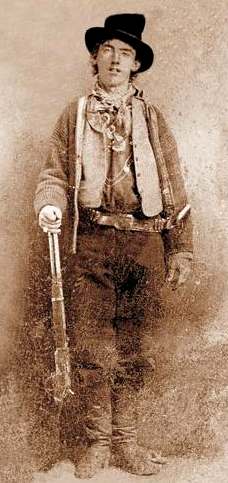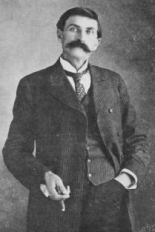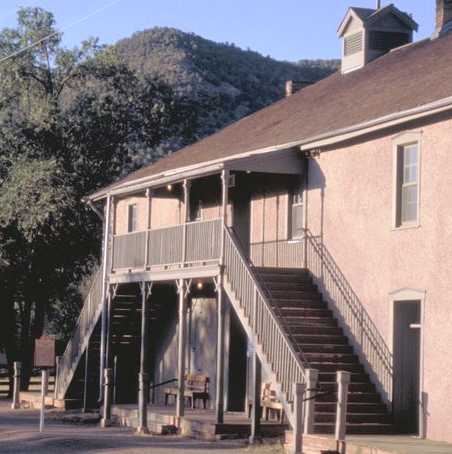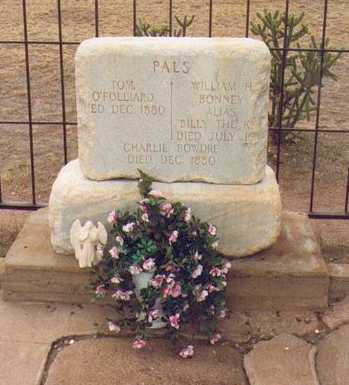|
BILLY THE KID
|
||||||||||||||||||||||
|
HOME | BIOLOGY | FILMS | GEOGRAPHY | HISTORY | INDEX | INVESTORS | MUSIC | SOLAR BOATS | SPORT |
||||||||||||||||||||||
|
Henry McCarty (November 23, 1859 – July 14, 1881) better known as Billy the Kid, but also known by the aliases Henry Antrim and William Harrison Bonney, was a 19th century American frontier outlaw and murderer who was a participant in the Lincoln County War.
He was reputed to have killed 21 men, one for each year of his life, but the actual total is probably closer to nine (four on his own and five with the help of others). Short and lithe, McCarty had blue eyes, smooth cheeks and prominent front teeth. Many newspaper reporters said, "Billy is handsome and very easy going." He was also personable and quick to laugh, but these qualities masked a fierce temper and a single-minded resolve which, combined with superior shooting skills and an almost animal cunning, served to make him a dangerous outlaw. His most noticeable apparel was a sugar-loaf Sombrero hat with a wide green decorative band. Although little known in his own lifetime, McCarty was catapulted into legend in the year after his death when his killer, Sheriff Patrick Garrett, published a wildly sensationalistic, biography of the outlaw called The Authentic Life of Billy, the Kid. Beginning with Garrett's account, Billy the Kid would grow into perhaps the most famous and symbolic figure of the American Old West.
Henry McCarty - Billy the Kid
Biography
Early life
Little is known about McCarty's background but he is thought to have been born in New York. His parents were of Irish Protestant descent, but their exact names, and thus McCarty's own surname, are not known for certain. Variations for his parents' names include: Catherine McCarty or Katherine McCarty Bonney for his mother and William Bonney or Patrick Henry McCarty for his father (who probably died around the end of the American Civil War). In 1868 his mother met William Antrim and, after several years of hopscotching around the country with Henry and his half-brother Joseph in tow, the couple married and settled in Silver City, New Mexico in 1873. Antrim found sporadic work as a bartender and carpenter but soon became more interested in prospecting for fortune than in his wife and stepsons; despite this, young McCarty sometimes referred to himself by the surname 'Antrim'.
Faced with an indigent husband, McCarty's mother took in boarders in order to provide for her sons. She was by now afflicted with tuberculosis even though she was seen by her boarders and neighbors as "a jolly Irish lady, full of life and mischief". The following year, on 16 September 1874, his mother died of her condition and at 14 McCarty was forced to find work in a hotel. The manager was impressed by the young boy, boasting that he was the only kid who ever worked for him that didn't steal anything. His school teachers thought that the young orphan was "no more of a problem than any other boy, always quite willing to help with chores around the schoolhouse".
On September 23, 1875 McCarty was arrested for hiding a bundle of stolen clothes for a man playing a prank on a Chinese laundryman. Two days after McCarty was thrown in jail, the scrawny teen escaped by worming his way up the jailhouse chimney. From that point onward McCarty would be a fugitive.
He eventually found work as an itinerant ranch hand and shepherd in southeastern Arizona. In 1877 he became a civilian teamster at Camp Grant Army Post, with the duty of hauling logs from a timber camp to a sawmill. The civilian blacksmith at the camp, Frank "Windy" Cahill, took pleasure in bullying young McCarty. On August 17 Cahill attacked McCarty after a verbal exchange and threw him to the ground. McCarty retaliated by drawing his gun and shooting Cahill, who died the next day. Once again McCarty was in custody, this time in the Camp's guardhouse awaiting the arrival of the local marshal. Before the marshal could arrive, however, McCarty escaped. It has also been reported that the encounter with Frank Cahill took place in a saloon.
Again on the run, McCarty, who had begun to refer to himself as Willam H. Bonney, next turns up in the house of a Heiskell Jones in Pecos Valley, New Mexico. Apaches had stolen McCarty's horse which forced him to walk many miles to the nearest settlement, which was Mrs. Jones's house. She nursed the young man, who was near death, back to health. The Jones family developed a strong attachment to McCarty and gave him one of their horses.
Lincoln County Cattle War
In the fall of 1877 McCarty/Bonney moved to Lincoln County, New Mexico and was hired as a cattle guard by John Tunstall, (an English cattle rancher, banker, and merchant), and his partner, Alexander McSween, (a prominent lawyer).
A conflict, soon to become known as the Lincoln County Cattle War, had begun between the established town merchants (called "The House") and the ranchers. Events turned bloody on February 18, 1878, when Tunstall, unarmed, was caught on an open range while herding cattle and shot to death by members of "The House". Tunstall's murder enraged Bonney and the other ranch hands.
They formed their own enforcement group called The Regulators, led by ranch hand Richard Brewer (known as "Dick" Brewer), and proceeded to hunt down two of the members of the posse that had killed Tunstall. They captured Bill Morton and Frank Baker on March 6th, and killed them on March 9th. This occurred near Agua Negra. While returning to Lincoln they also killed one of their own members, named McCloskey, whom they suspected to be a traitor.
On April 1st, Regulators Jim French, Frank MacNab, John Middleton, Fred Waite, and McCarty ambushed Sheriff William Brady and his deputy, killing them both. McCarty was wounded while trying to retrieve a rifle belonging to him, taken from him by Brady in an earlier arrest.
On April 4th, they tracked down and killed an old buffalo hunter known as "Buckshot" Roberts, whom they suspected of involvement in the Tunstall murder, but not before Roberts shot and killed Dick Brewer, who had been the Regulators' leader up until that point. Two other Regulators were wounded during the gun battle, which took place at Blazer's Mill. McCarty took over as leader of the Regulators following Brewer's death. Under indictment for the Brady killing, McCarty and his gang spent the next several months in hiding, and were trapped, along with McSween, in McSween's home in Lincoln on July 15, 1878, by members of "The House" and some of Brady's men.
After a five day siege, McSween's house was set on fire; McCarty and the other Regulators fled, McCarty killing an enforcer named Bob Beckwith in the process. McSween was shot down while fleeing the blaze, and his death essentially marked the end of the Lincoln County Cattle War.
Lew Wallace and amnesty
In the autumn of 1878, retired Union General Lew Wallace became the new territorial governor of New Mexico. In order to restore peace to Lincoln County, Wallace proclaimed an amnesty for any man involved in the Lincoln County War who was not already under indictment. McCarty, who had fled to Texas after escaping from McSween's house, was under indictment but Wallace was intrigued by rumors that the young man was willing to surrender himself and testify against other combatants if amnesty could be extended to him. In March of 1879 Wallace and McCarty, now back in the Lincoln area, met to discuss the possibility of a deal. True to form, McCarty greeted the Governor with a revolver in one hand and a Winchester rifle in the other. After several days to consider Wallace's offer, McCarty agreed to testify in return for amnesty.
The arrangement called for McCarty to submit to a show arrest and a short stay in jail until the conclusion of his courtroom testimony. Although McCartys' testimony helped to indict John Dolan, (one of the powerful House faction leaders), the district attorney defied Wallace's order to set McCarty free after testifying. Instead, Billy was returned to jail in June, 1879. A natural-born escape artist, McCarty slipped out of his handcuffs and fled.
For the next year and a half, McCarty survived by rustling, gambling and killing. In January 1880, during a well-documented altercation, he shot dead a would-be outlaw named Joe Grant in a Fort Sumner saloon. When asked about the incident later, The Kid remarked, "It was a game for two, and I got there first". He became a fixture around Fort Sumner on the Pecos River.
McCarty drew enough attention to himself through his activities as a cattle rustler that he and his gang were pursued by a posse and trapped inside a ranchhouse, (owned by friend James Greathouse at Anton Chico in the White Oaks area) in November 1880. A posse member named James Carlysle ventured into the house under flag of truce in an attempt to negotiate the group's surrender, with Greathouse being sent out as a hostage for the posse. At some point in the night it became apparent to Carlysle that the outlaws were stalling, when suddenly a shot was accidentally fired from outside. Carlysle, assuming the posse members had shot Greathouse, decided to run for his life, crashing through a window into the snow outside. As he did so, the posse, mistaking Carlysle for one of the gang, fired on him and killed him. Realizing what they had done and now demoralized, the posse broke up, allowing McCarty and his gang to slip away. The Kid later wrote to Governor Wallace claiming innocence in the killing of Carlysle, and of involvement in cattle rustling in general.
Pat Garret
Pat Garrett
During this time, the Kid also developed a fateful friendship with an ambitious local bartender and former buffalo hunter named Patrick Garrett. Running on a platform to rid the area of rustlers, Garrett was elected as sheriff of Lincoln County in November 1880, and in early December of that year he put together a posse and set out to apprehend McCarty, now known almost exclusively as Billy the Kid and carrying a $500 bounty on his head.
The posse led by Garrett fared much better, and his men closed in quickly. On December 19, McCarty barely escaped the posse's midnight ambush in Fort Sumner, during which one of McCarty's gang, Tom O'Folliard, was shot to death. On December 23rd he was tracked to an abandoned stone building located in a remote location called Stinking Springs.
While McCarty and his gang were asleep inside, Garrett's posse surrounded the building and waited for sunrise. The next morning, a cattle rustler named Charlie Bowdre stepped outside to feed his horse and, mistaken for McCarty, was shot dead by the posse. Soon afterward somebody from within the building reached for the horse's halter rope but Garrett shot and killed the horse (the horse's body then blocked the only exit). As the lawmen began to cook breakfast over an open fire, Garrett and McCarty engaged in a friendly conversation exchange: Garrett inviting McCarty outside to eat, McCarty inviting Garrett to "go to hell." Realizing that they had no hope of escape, the besieged and hungry outlaws finally surrendered later that day and were allowed to join in the meal.
Courthouse and jail, Lincoln, New Mexico
Escape from Lincoln
McCarty was jailed in the town of Mesilla while waiting for his April 1881 trial, and spent his time giving newspaper interviews - he was by now a famous local figure - and also peppering Governor Wallace with letters seeking clemency. Wallace, however, refused to intervene. McCarty's trial took exactly one day, and resulted in his conviction for murdering Sheriff Brady - the only conviction ever secured against any of the combatants, on either side, in the Lincoln County Cattle War.
On April 13 he was sentenced by Judge Warren Bristol to hang. The execution was scheduled for May 13 and he was sent to Lincoln to await this date, held under guard by two of Garrett's deputies, James Bell and Robert Ollinger, on the top floor of the town's courthouse. On April 28, while Garrett was out of town, McCarty stunned the territory by killing both of his guards and escaping. Some of the details of the escape are unclear. Some historians believe that a friend or Regulator sympathizer left a pistol in a nearby privy that McCarty was allowed to use, under escort, each day; McCarty then retrieved this gun while in the privy and, after Bell had led him back to the courthouse, turned it on his guard as the two of them reached the top of a flight of stairs inside. Another theory holds that McCarty slipped his manacles at the top of the stairs, struck Bell over the head with them and then grabbed Bell's own gun and shot him.
However it happened, Bell staggered out into the street and collapsed, mortally wounded. Meanwhile, McCarty scooped up Ollinger's ten-gauge double barrel shotgun and waited at the upstairs window for Ollinger, who had been across the street with some other prisoners, to come to Bell's aid. As Ollinger came running into view, McCarty leveled the shotgun at him, called out "Hello, Bob" and shot him dead. The townsfolk supposedly gave him an hour that he used to remove his leg iron. That hour was given in thanks for his work as part of "The Regulators." After cutting his leg irons with an axe, the young outlaw borrowed (or stole) a horse and rode leisurely out of town, reportedly singing, leaving the terrified townsfolk in his wake. The horse was returned 2 days later.
Billy the Kid's grave, Fort Sumner, New Mexico
Death
McCarty's freedom would prove short-lived, however. Responding to rumours that McCarty was still lurking in the vicinity of Fort Sumner almost three months after his escape, Sherriff Garrett and two deputies set out on July 14, 1881 to question one of the town's residents, a friend of McCarty's named Pete Maxwell. Near midnight, as Garrett and Maxwell sat talking in Maxwell's darkened bedroom, the Kid himself unexpectedly entered the room. There are at least two versions of what happened next.
One version says that as the Kid entered, he could not recognize Garrett in the poor light, McCarty drew his pistol and backed away, asking "¿Quién es? ¿Quién es?" (Spanish for "Who is it? Who is it?"). Recognizing McCarty's voice, Garrett drew his own pistol and fired twice, the first bullet hitting McCarty just above his heart and killing him instantly.
In a second version, McCarty entered carrying a knife, evidently headed to a kitchen area. He noticed someone in the darkness, and uttered the words "¿Quién es? ¿Quién es?", at which point he was shot and killed in ambush style.
Although the popularity of the first story persists, and does reflect Garrett in a better light, some historians contend that the latter version is probably the accurate one.
Henry McCarty, alias Henry Antrim, alias William H. Bonney, alias Billy the Kid, was buried the next day in Fort Sumner's old military cemetery, between his fallen companions Tom O'Folliard and Charlie Bowdre. A single tombstone was later erected over the graves, giving the three outlaws' names and with the word "Pals" also carved into it.
Notoriety, fact vs reputation
As with many men of the old west dubbed gunfighters, his reputation outweighed the actual facts of gunfights he was involved in.
Despite being credited with the killing of 21 men in his lifetime, William H. Bonney is only known to have participated in the killing of 9 men. Five of them were during shootouts in which up to between 5 to 10 or more of the 40 plus total "Regulators" took part, therefore making it unknown whether or not it was Bonney's bullets that did the killing. Of the remaining four Bonney victims, two were in self-defense gunfights, and the other two were the killings of Deputies Bell and Ollinger during his jail escape.
Left-handed or right-handed?
For most of the 20th century, it was widely assumed that Billy the Kid was left-handed. This belief came from the fact that the only known photograph of Billy, an undated ferrotype, shows him with a Model 1873 Winchester rifle in his right hand and a gun belt with a holster on his left side, where a left handed person would typically wear a pistol. The belief became so entrenched that in 1958, a biographical film was made about Billy the Kid called The Left Handed Gun starring Paul Newman.
It wasn't until late in the 20th century when it became general knowledge that the familiar ferrotype was actually a reverse image. This version shows Billy's Model 1873 Winchester with the loading port on the left side. All Model 1873s had the loading port on the right side proving the image was reversed and that Billy was in fact wearing his pistol on his right hip. Even though the image has been proven to be reversed, the idea of a left handed Billy the Kid continues to widely circulate.
Perhaps because many people heard both of these arguments and confused them, it is widely believed that Billy the Kid was ambidextrous. Many Billy the Kid sites describe him as such. Brushy Bill
In 1950, a lawyer named William Morrison located a man in West Texas named Ollie P. Roberts, nicknamed Brushy Bill, who claimed to be the actual Billy the Kid, and that he indeed had not been shot and killed by Pat Garrett in 1881. Almost all historians reject the Brushy Bill claim. Among other problems, the real Billy the Kid spoke Spanish fluently and could read and write, whereas Brushy Bill apparently could not speak Spanish at all, and was illiterate.
Despite this and discrepancies in birth dates and physical appearance, the Town of Hico, Texas (Brushy Bill's residence) has capitalized on the Kid's infamy by opening the Billy The Kid Museum.
Another claimant, also likely to be a hoax, was John Miller, who claimed to be Billy the Kid in 1938.
In film, literature, and music
Billy the Kid has been the subject or inspiration for many works of art, including:
LINKS and REFERENCE
A taste for adventure capitalists
Solar Cola - a healthier alternative
|
||||||||||||||||||||||
|
This
website
is Copyright © 1999 & 2006 NJK. The bird The name '1824' is a trade mark of Solar Cola Ltd. All rights reserved. Max Energy Limited is an educational charity. |
||||||||||||||||||||||
|
AUTOMOTIVE | BLUEBIRD | ELECTRIC CARS | ELECTRIC CYCLES | SOLAR CARS |



